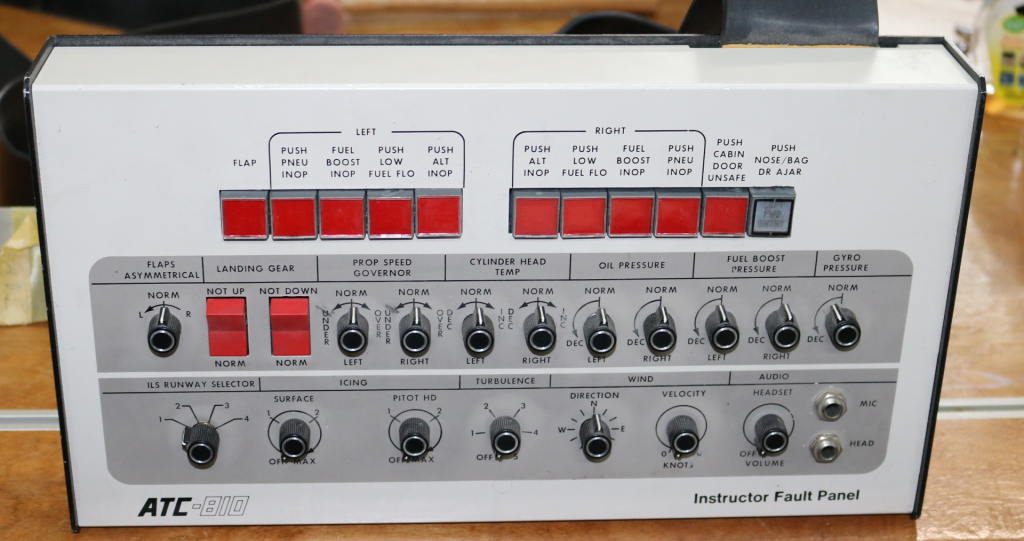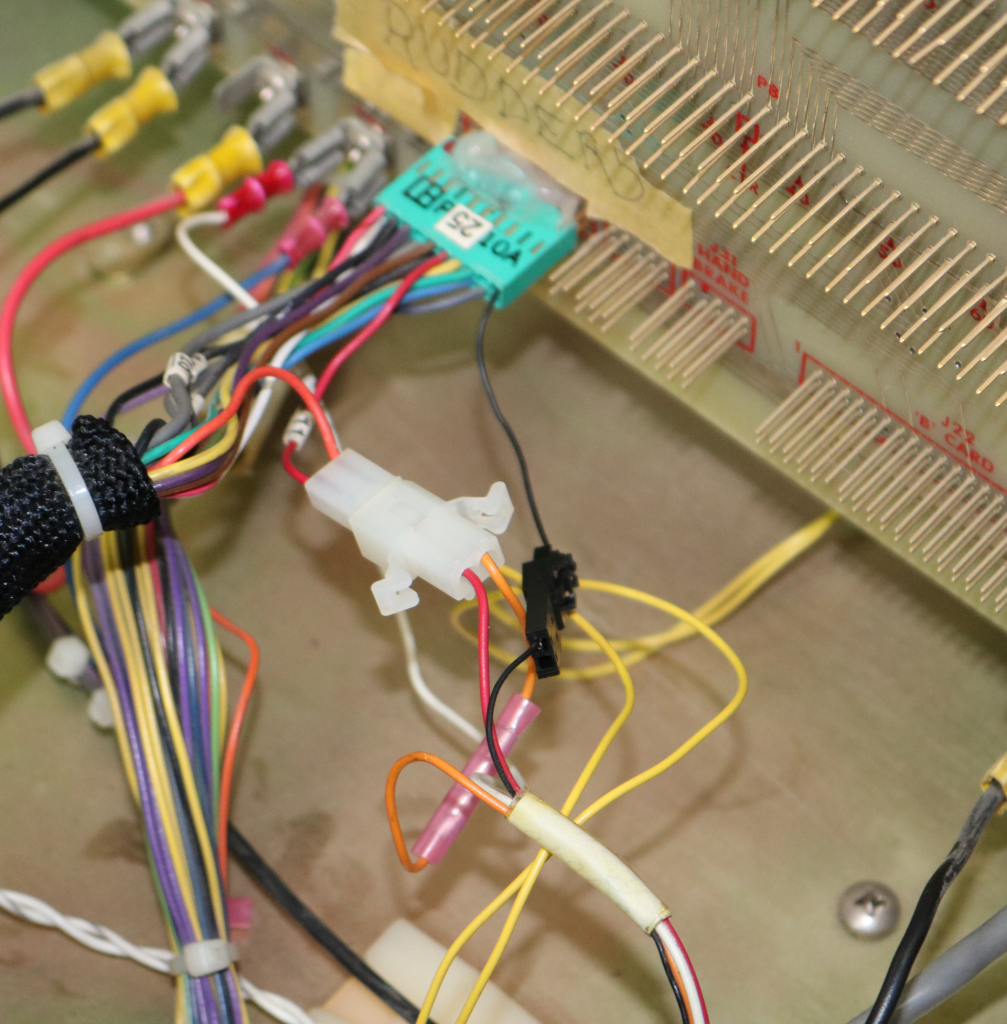This is a site I’ve set up in order to chronicle the journey I’m taking with the restoration and eventual modernization of the Analog Training Computers ATC-810 Twin Engine CPT/IFR Flight Simulator.
At the time this ATC-810 was built in 1982, it met both the 50 and 100 percent maximum simulation times that were authorized by Part 141. At some point I’ll upload the various LoAs I have for the ATC-810, but the relevant portion is here:
With the enclosed pilot station, the trainer meets the requirements of FAR Section 141.4l(a)(2) for 50 percent of the allowable simulator times. With the further addition of the X-Y Plotter, the trainer meets the requirements of FAR Section 141.4l(a) (1) and may be used to meet the 100 percent maximum authorization provided total simulator time is devoted to instrument training and is approved in a training course outline.
A the time of its development, the ATC-810 was a state of the art training device both for new pilots and those that were training in order to obtain their IFR (Instrument Flight Rules) endorsement. It provided an enclosed simulation environment and was equipped with a complete instrument panel filled with all the necessary instruments needed to operate and navigate a light twin aircraft. The simulator came equipped with an “Instructor Fault Panel” that would allow a flight instructor to introduce faults or change aspects of the simulator in order to provide useful training scenarios. A photo of the Instructor Fault Panel is shown below. This is the unit included with my ATC-810.

Wait, this is a real flight simulator?
Yes. Even today the ATC-810 could potentially qualify as a BATD (Basic Aviation Training Device) according to Appendix B of AC 61-136B. That being said, the Instructor Fault Panel (IFP) is missing a few key features, such as being able to freeze the simulator or disrupt/disable specific instruments in the cockpit. If the IFP deficiencies were rectified and I had an enormous wheelbarrow filled with money I could light on fire, I could have the ATC-810 certified as a BATD. If I added some additional avionics (GPS and likely a two-axis autopilot) and a visual system, I could probably go for an AATD certification. However, since I do not currently possess a wheelbarrow filled with cash I can light on fire, these things are not in the future of this particular flight simulator.
So what’s the plan, man?
Ahh yes. What in the hell am I going to do with a commercial flight simulator? Well first of all, I’m going to fly it! I mean, that’s the whole point, right?
As the ‘810 sits right now, it’s perfectly “flight worthy”. As-delivered to me, it had two issues. The first was three cut wires – those I repaired on 9/7. (I used connectors in order to avoid any potential future wire-cutting.)

I haven’t traced the wires out yet, but I suspect they may be related to the rudder pedals in some fashion or another. I’m sure I’ll discover that information soon.
The second issue is related to the “control feel” system that is attached to the rudder pedal linkage. The intent of the device is to require the pilot to input more yaw control when a single engine fails in the aircraft. (An engine failure in a twin engine aircraft will result in a great deal of adverse yaw towards the failed engine.) This system is driven by an AC motor that’s coupled to a pulley via a small belt. I need to either fabricate or obtain a replacement for that belt. Once that’s done, the simulator will be at 100%.
There are a few other issues, but they’re either cosmetic (scratched finishes, paint peeling off the pilot’s seat) or minor structural faults – centered on putting screws edge-in to plywood.
My long term plan with the ATC-810 is to get it modernized. By that I mean I want to get a modern PC flight simulator such as FlightGear interfaced to the avionics and controls. However, I want to accomplish that in a 100% reversible process. This means that I need to create replacements for the digital and analog electronics that drive the simulator, and I need to do it in such a manner that won’t result in any permanent modifications to the existing hardware. I’m confident that I can do this by connecting to the existing backplane. This would require that I fabricate replacements for all the controls presented on the four interface cards, but I don’t see that as being a problem. (The four interface cards that I’m referring to can be seen here: https://www.geneb.org/atc-810. They’re literally the brains of the simulator)
As part of the cleanup and repair process, I needed to remove the “skin” off the simulator. Here’s a video that shows that process and a discussion of what lies under the hood: https://www.youtube.com/watch?v=WFtdODWNXl4
Until next time!

Great blog you have going here. Two more days until I get my 810. If I understand you correctly your plan is to replace the nav/com stack (those boards) with a modern digital stack that will communicate with the instrumentation and other functions of the sim as well as your PC based flight program?
Kind of. I’m going to develop a set of boards that are a LOT smaller that will just plug into the existing backplane. The radio stack will be a separate thing that will be connected to some of those new boards via ribbon cable.
There will be 8 cards total and they’ll be supported in pairs by some kind of carrier/support frame that will fully support the new boards within the existing space.
The first step in that process will be to identify what pin does what in each of the 8 72 pin backplane connectors. I’m 90% there with the schematics, but I need to do some probing to make sure I’m understanding them how they’re written. That will result in some clearer documentation as I go through each connector.
If your 810 is equipped with an HSI, just be aware that it’s a REAL HSI and would be astronomically expensive for you to have repaired. Be careful with it. 😉 I’m going to be building a replica of a Garmin G5 in order to replace the HSI in my panel, primarily to avoid wear & tear on it. I may also replace the AI with a G5. (The Garmin G5 has two “modes”, an ADI and an HSI – it’s a pretty cool thing. I’ve found a source of 320×240 LCD panels that can be driven via Raspberry Pi. It wouldn’t be that difficult to create a basic emulation of the device for the ‘810.)
Make sure you grab the maintenance manual and schematic set – the maint. manual has everything you need to go over the ‘810 100%. Take photos when you get it! 🙂
Wow, I have to tell you I think I Am might be biting off more than I can chew. Lol. Sounds like you really know what you doing here. I have very limited electronics knowledge and am not sure where to even start. From some videos on YouTube I see folks using Arduino MP’s to connect to each individual instrument (I.e gear up, flaps, switches Etc). Is it not possible to use the existing nav/com setup and interface it the same way? I hope you don’t mind these novice questions. I don’t mind putting in the research and learning as I go.
Yes, mine does have an HSI btw.
I am in Southwestern Illinois about 15 minutes from St. Louis. I am a licensed aircraft dispatcher and currently work for the Dept of Defense as a flight manager. I am also a private pilot but haven’t flown in about 15 years. I’ve always been a Flight sim enthusiast and when I found this sim at a RIDICULOUS low price I had to jump on the deal. I am looking forward to hearing from you. Thanks!
The first thing you’re going to want to do is get yourself a ground strap and some static bags large enough to hold the 12.4″ x 12″ circuit boards. You do not want to nuke those chips. 🙂
This is what your boards are going to look like:
https://www.geneb.org/atc-810/
Each of the four boards also is part of the radio stack.
I actually know the guy that did those videos you watched. 🙂 At some point I’m going to hassle him for the code to drive some of the gauges. The things like the oil, pressure, rpm, etc. are easy to drive because they’re D’Arsonval meters and can be fed with a simple PWM signal. The others require a bipolar DAC (or two) to drive because they’re working with +/- voltages to move the pointer.
The problem with using the existing radio stack is figuring out how to pull “data” from it. You figure that the only microprocessor in there handles two things (from what I’ve read) – fuel consumption and navigation. The whole rest of the simulation is driven by analog circuitry. It’s pretty amazing.
Are you getting the Fault Panel with your 810? Any documentation at all?
Yes it has the fault/instructor panel as well as the user manual and a couple of cassette tapes. I’ve got pics I can show you but I don’t think I can post them on this blog. Feel free to email me if you like: Kc9nbe@gmail.com
Where are you located? It’s Greg right?
I got the sim in my garage. Turned it on and got some arcing and sparking
Under the rudder peddles with some smoke. YIKES!!!
Quickly shut it down and this Morning I start to disassemble the shell.
Is there a way to get under the decking to access the rudder assembly?
Also, you would not believe all the documents I have with this. To include the complete drawings volume. Wow.
Did you not get my email the other day? My email address is geneb at deltasoft.com.
g.
Hi,
I was reading through the resources on your site. Thank you for publishing.
I’m wondering if you have a users/owners manual?
I scanned and uploaded all the ATC-810 material I have to the Internet Archive. You can find it with this link: https://archive.org/search.php?query=ATC-810&sin=